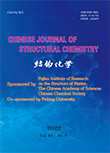Two Polynuclear Fe Complexes with Boat-like Core: Syntheses, Structures and Magnetic Properties
YANG Na, YANG Hua*, TIAN Hai-Quan, LI Da-Cheng, DOU Jian-Min*
Chin. J. Struct. Chem. 2022, 41, 2203047-2203054 DOI: 10.14102/j.cnki.0254-5861.2011-3311
March 15, 2022
crystal structures, magnetic properties, Schiff-base, metallamacrocycle
ABSTRACT
Two novel polynuclear
complexes {NaFe4(μ4-O)(L)4(μ2-Cl)[Fe(CN)5NO](H2O)(DMF)2} (1) and {NaFe4(μ4-O)(L)4(μ2-OEt)[Fe(CN)5NO](H2O)(DMF)2} (2) have been prepared using the tetradentate
N-(2-hydroxy- ethyl)-3-methoxysalicylaldimine Schiff-base ligand (H2L)
with the help of [Fe(CN)5NO]2- linkers, where the ligand was
in situ synthesized through the condensation of o-vanillin and ethanolamine in the formation process of complexes. The
resulting complexes possess “boat-like” structure constructed through three Fe
ions and one Na ion with the fourth Fe ion acting as the “paddle”. The “hull
bottom” contains an eight-membered metallamacrocycle with metalla- crown-like motif
and [-M-O-] repeat unit. Both complexes display three-dimensional
frameworks through C–H∙∙∙N hydrogen bonds, C–H∙∙∙Cl hydrogen
bonds, and π-π stacking interactions with the introduction of solvent molecules and coordination anions. Variable-temperature magnetic susceptibility
measurements reveal strong antiferromagnetic couplings between the metal
centers in complexes 1 and 2.








